
Asclepias tuberosa, the butterfly weed, is a species of milkweed native to eastern and southwestern North America. It is commonly known as butterfly weed because of the butterflies that are attracted to the plant by its color and its copious production of nectar. It is also a larval food plant of the queen and monarch butterflies, as well as the dogbane tiger moth, milkweed tussock moth, and the unexpected cycnia Hummingbirds, bees and other insects are also attracted.

The monarch butterfly or simply monarch is a milkweed butterfly in the family Nymphalidae. Other common names, depending on region, include milkweed, common tiger, wanderer, and black veined brown. It may be the most familiar North American butterfly, and is considered an iconic pollinator species. Its wings feature an easily recognizable black, orange, and white pattern, with a wingspan of 8.9–10.2 cm(3 1⁄2–4 in) A Müllerian mimic, the viceroy butterfly, is similar in color and pattern, but is markedly smaller and has an extra black stripe across each hindwing.

Asclepias is a genus of herbaceous, perennial, flowering plants known as milkweeds, named for their latex, a milky substance containing cardiac glycosides termed cardenolides, exuded where cells are damaged. Most species are toxic to humans and many other species, primarily due to the presence of cardenolides, although, as with many such plants, there are species that feed upon them and from them. The genus contains over 200 species distributed broadly across Africa, North America, and South America. It previously belonged to the family Asclepiadaceae, which is now classified as the subfamily Asclepiadoideae of the dogbane family, Apocynaceae.

Asclepias syriaca, commonly called common milkweed, butterfly flower, silkweed, silky swallow-wort, and Virginia silkweed, is a species of flowering plant. It is in the genus Asclepias, the milkweeds. It is native to southern Canada and much of the United States east of the Rocky Mountains, excluding the drier parts of the prairies. It grows in sandy soils as well as other kinds of soils in sunny areas.

Asclepias incarnata, the swamp milkweed, rose milkweed, rose milkflower, swamp silkweed, or white Indian hemp, is a herbaceous perennial plant species native to North America. It grows in damp through wet soils and also is cultivated as a garden plant for its flowers, which attract butterflies and other pollinators with nectar. Like most other milkweeds, it has latex containing toxic chemicals, a characteristic that repels insects and other herbivorous animals.

Asclepias asperula, commonly called green-flowered milkweed or spider antelope horns, is a species of milkweed native to the Southwestern United States and northern Mexico.

Asclepias curassavica, commonly known as tropical milkweed, is a flowering plant species of the milkweed genus, Asclepias. It is native to the American tropics and has a pantropical distribution as an introduced species. Other common names include bloodflower or blood flower, cotton bush, hierba de la cucaracha, Mexican butterfly weed, redhead, scarlet milkweed, and wild ipecacuanha.

Asclepias verticillata, the whorled milkweed, eastern whorled milkweed, or horsetail milkweed, is a species of milkweed native to most all of eastern North America and parts of western Canada and the United States.
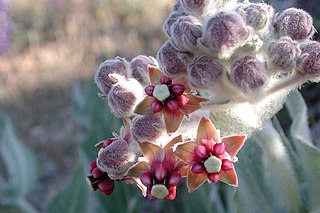
Asclepias californica is a species of milkweed known by the common name California milkweed. It grows throughout lower northern, central and southern California.

Asclepias erosa is a species of milkweed known commonly as desert milkweed. It is native to southern California, Arizona, and northern Baja California, where it is most abundant in the desert regions.

Asclepias subulata is a species of milkweed known commonly as the rush milkweed, desert milkweed or ajamete. This is an erect perennial herb which loses its leaves early in the season and stands as a cluster of naked stalks. Atop the stems are inflorescences of distinctive flowers. Each cream-white flower has a reflexed corolla that reveals the inner parts, a network of five shiny columns, each topped with a tiny hook. The fruit is a pouchlike follicle that contains many flat, oval seeds with long, silky hairlike plumes. This milkweed is native to the desert southwest of the United States and northern Mexico.

Asclepias cordifolia is a species of milkweed commonly called heart-leaf milkweed or purple milkweed. It is native to the western United States, growing between 50 to 2,000 m elevation in the northern Sierra Nevada and Cascade ranges. Heart-leaf milkweed was valued by the Native American Miwok tribe for its stems, which they dried and processed into string and rope.
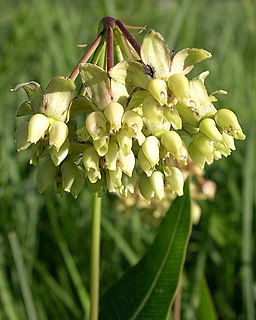
Asclepias meadii is a rare species of milkweed known by the common name Mead's milkweed. It is native to the American Midwest, where it was probably once quite widespread in the tallgrass prairie. Today much of the Midwest has been fragmented and claimed for agriculture, and the remaining prairie habitat is degraded.
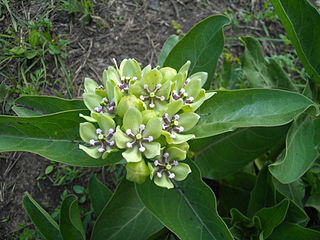
Asclepias viridis is a species of flowering plant in the dogbane family known by the common names green antelopehorn and spider milkweed. It is native to the southcentral and southeastern United States.
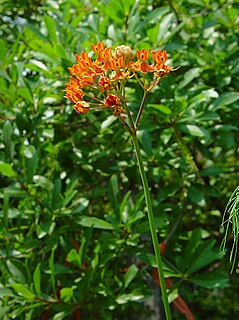
Asclepias lanceolata, the fewflower milkweed, is a species of milkweed that is native to the coastal plain of the United States from New Jersey to Florida and Southeast Texas. A. lanceolata is an upright, perennial plant that can grow between 3 and 5 feet tall, with red-orange flowers blooming in the summer months. It can also be referred to as Cedar Hill milkweed, as it was first described by Dr. Eli Ives in the neighborhood of Cedar Hill in New Haven, Connecticut.

Asclepias sullivantii is a species of flowering plant in the milkweed genus, Asclepias. Common names include prairie milkweed, Sullivant's milkweed, and smooth milkweed. It is native to North America, where it occurs in the central United States and Ontario in Canada.

Asclepias exaltata is a species of flowering plant in the dogbane family, native to eastern North America.
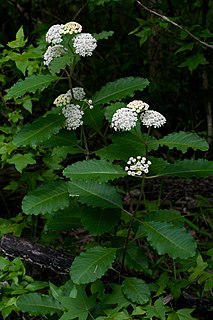
Asclepias variegata, commonly called the redring milkweed or white milkweed, is a plant in the family Apocynaceae. It is native to eastern North America, where it is found in Canada and the United States. It is most common in the Southeastern United States, and becomes rare in the northern edge of its range.
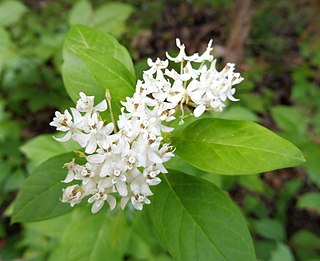
Asclepias texana, commonly called Texas milkweed, is a species of flowering plant in the dogbane family (Apocynaceae). It is native to North America, where it is widespread in the regions of the Chihuahuan Desert and Edwards Plateau. Its range spans from the states of Durango and Coahuilla in Mexico, north to the state of Texas in the United States. Its natural habitat is in dry rocky areas in canyons or along arroyos.

Asclepias perennis, also known as aquatic milkweed or white swamp milkweed, is a North American species of milkweed that is found throughout the Coastal Plain from eastern Texas to southern South Carolina, northward along the Mississippi River, and into the Ohio Valley of Illinois, Indiana, and Kentucky. There seems to be a few disjunct populations in Arkansas, Texas, and Indiana.





















